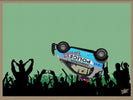
Velocity Rendered Artistic Celebrations of Automotive Mastery
, by Bobby Banks, 2 min reading time

, by Bobby Banks, 2 min reading time
In the mid-20th century, pop art emerged, characterized by its embrace of popular culture and consumer goods, including the imagery of automobiles. Artists like Andy Warhol and Roy Lichtenstein saw cars as icons of modern life and consumerism. Warhol's silkscreen series of Mercedes-Benz and Lichtenstein's comic-strip style car scenes are seminal examples of how cars were incorporated into the narrative of pop art, celebrating and critiquing the role they play in society.
Street art, known for its public accessibility and often subversive nature, has also been a platform where automobiles, particularly sports and luxury cars, are prevalent subjects. These cars, symbols of speed, power, and wealth, are recontextualized in urban environments through murals and tags. Artists like D*Face and Alec Monopoly have famously used the imagery of high-end cars to both critique and laud the excesses of contemporary culture.
In graffiti culture, cars have been depicted as trophies and as totems of personal expression. The sports car's sleek design and luxury vehicles' association with status make them compelling subjects for graffiti artists, who often paint these cars with vibrant colors and exaggerated features, pushing the boundaries of design into the realm of the fantastic.
Today, contemporary artists continue to be inspired by cars. Sports and luxury cars, with their connotations of speed, technology, and luxury, provide fertile ground for exploring contemporary issues such as identity, consumption, and the environment. Artists create sculptures, installations, and interactive pieces that prompt viewers to consider their relationship with these machines and the cultural values they represent. The journey of cars, sports cars, and luxury vehicles through the landscape of art is as varied and dynamic as the designs of the cars themselves. As symbols of human aspiration and cultural markers, they continue to captivate and inspire, driving forward the conversation about what art is and can be. Whether on the canvas, the wall, or the street, cars remain a potent symbol in the visual dialogue of our times.